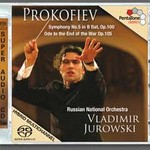
Symphony No. 5 in B flat / Ode to the End of the War, Op. 105
 $40.00
Out of Stock
$40.00
Out of Stock6+ weeks add to cart
PROKOFIEV
Symphony No. 5 in B flat / Ode to the End of the War, Op. 105
Russian National Orchestra / Vladimir Jurowski
[ Pentatone SACD / SACD ]
Release Date: Saturday 20 October 2007
This item is currently out of stock. It may take 6 or more weeks to obtain from when you place your order as this is a specialist product.
He died on the same day as Stalin. Not only did March 5, 1953 see the ending of the life of the Soviet dictator who despised mankind, but also of the life journey of Sergei Prokofiev, which had travelled its winding path for more than 60 years and not always developed in the most predictable manner.
- On Hybrid Super Audio CD (SACD) format, presented in full 5.1 surround sound! PLAYABLE ON ANY CD SYSTEM
He died on the same day as Stalin. Not only did March 5, 1953 see the ending of the life of the Soviet dictator who despised mankind, but also of the life journey of Sergei Prokofiev, which had travelled its winding path for more than 60 years and not always developed in the most predictable manner. Stalin's funeral was a state ceremony, whereas Prokofiev's burial merited a brief report only.
Prokofiev was born in 1891 as the son of an estate manager. As a young man and graduate of the St. Petersburg Conservatoire, he became the enfant terrible of the Russian music scene thanks to compositions such as his Scythian Suite, before leaving for the U.S.A. in 1918. After 1923, he lived and composed in Paris for almost a decade, with interruptions for various concert tours to his native Russia. In contrast to Stravinsky, for example, Prokofiev never really adapted to living abroad, and thus he returned to the Soviet Union in 1936, despite the patently obvious political signs. This return was inevitable - and simultaneously disastrous. Although Prokofiev managed to quickly overcome the artistic crisis from which he had suffered during his years in Paris, he was now faced with the inexorable cultural-political doctrine of the Soviet Union. Harassment and surveillance were the order of the day. According to the notorious resolution taken by the Central Committee on February 10, 1948, Prokofiev's music was also considered "formalist" and "hostile to the spirit of the people". After the war years, which had been highly successful for him as an artist and during which he had received masses of decorations and prizes (including various Stalin Prizes), his music instantly disappeared from the concert halls. His final years were marked by illness and despondency; however, he held on to his artistic integrity. Composer Alfred Schnittke writes as follows: "He provides a perfect example of how to remain human in an environment, which makes this almost impossible." Ten years after his death, the Soviet Union honoured one of its greatest musical sons with extensive festivities. And who was Stalin?
The historical East-West divide is at first highly apparent, as far as the reception of Prokofiev's works is concerned. For a long time in the West, people did not get along with the rather simple music of the Soviet period, which followed the cultural guidelines; and in the East, Prokofiev's western tendencies toward a modern approach remained on the whole well concealed. However, when classifying and assessing the works, there is one conspicuous constant, which crosses ideological borders: works such as Romeo and Juliet or Cinderella, Alexander Nevsky, Peter and the Wolf or the Symphony No. 5 are equally popular in both the West and the East; whereas the earlier, avant-garde works or the intricate later works received - and continue to receive - a less enthusiastic reception from the audiences.
Prokofiev wrote his Symphony No. 5 in B-flat, Op. 100 almost fifteen years after his fourth, in what was probably the darkest period of the past century, the year 1944. The last major battles of a deluded war were being fought, from which the Soviet Union emerged victorious. Prokofiev had been evacuated with various other composers from Moscow to Ivanovo, where he put the four-movement symphony to paper. During the previous years, since about 1930, his style of composition had clearly altered, becoming more simple and comprehensible: it had been described as "New Simplicity". Prokofiev the troublemaker and avant-gardist was a figment of the past. Certainly, this could be seen as being in accordance with the demands of "Socialist realism", but it is not inevitably the case.
The Symphony No. 5 is full of catchy tunes and melodic ideas, yet it remains transparent. It is an epic work, in the best sense of the word, and overwhelming in its purposiveness. Prokofiev himself described it as a symphony "in accordance with the dimensions of the human mind" and as "a hymn to free and happy people". Apart from these much-quoted statements, which in the end can mean a lot or just a little - always according to the importance a listener attaches to this - in this instance, Prokofiev came up with a symphonic work of the highest quality.
His "Ode to the End of the War", Op. 105, dates from 1945 and is written for a truly extraordinary ensemble of instruments. Prokofiev composed the work for 8 harps, 4 pianos, wind orchestra, percussion and 8 double basses! To this day, it does not receive the kudos it deserves, and is still lumped with the slogan "Socialistic Jubilation Orgy" at the victory of the Soviet Union over Fascism. The entire Ode consists of brilliant music, which even a composer such as Shostakovich - despite all their differences - could not overlook. If a listener is able to get into the unfamiliar, vice-like, perhaps even partially harsh sound, then he is sure to be left with an unforgettable experience.



